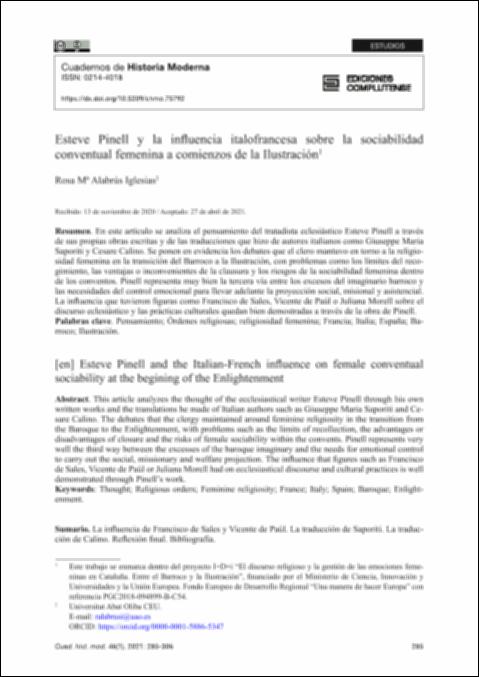Please use this identifier to cite or link to this item:
http://hdl.handle.net/10637/13605Esteve Pinell y la influencia italofrancesa sobre la sociabilidad conventual femenina a comienzos de la Ilustración
| Title: | Esteve Pinell y la influencia italofrancesa sobre la sociabilidad conventual femenina a comienzos de la Ilustración |
| Other Titles: | Esteve Pinell and the Italian-French influence on female conventual sociability at the begining of the Enlightenment |
| Authors : | Alabrús Iglesias, Rosa María |
| Keywords: | Mujeres en la religión.; Órdenes religiosas.; Pensamiento religioso.; Barroco.; Ilustración.; Dones en la religió.; Ordes religiosos.; Pensament religiós.; Barroc.; Il·lustració.; S. XVII-XVIII.; España; Italia.; Francia.; Espanya.; Itàlia.; França. |
| Publisher: | Madrid :Universidad Complutense de Madrid, 2021 |
| Citation: | Alabrús Iglesias, R.M. (2021). "Esteve Pinell y la influencia italofrancesa sobre la sociabilidad conventual femenina a comienzos de la Ilustración". Cuadernos de Historia Moderna, Volumen 46, Número 1 (2021), p. 285-306. ISSN 0214-4018. DOI: 10.5209/chmo.75792 |
| Abstract: | En este artículo se analiza el pensamiento del tratadista eclesiástico Esteve Pinell a través de sus propias obras escritas y de las traducciones que hizo de autores italianos como Giuseppe Maria Saporiti y Cesare Calino. Se ponen en evidencia los debates que el clero mantuvo en torno a la religio-sidad femenina en la transición del Barroco a la Ilustración, con problemas como los límites del reco-gimiento, las ventajas o inconvenientes de la clausura y los riesgos de la sociabilidad femenina dentro de los conventos. Pinell representa muy bien la tercera vía entre los excesos del imaginario barroco y las necesidades del control emocional para llevar adelante la proyección social, misional y asistencial. La influencia que tuvieron figuras como Francisco de Sales, Vicente de Paúl o Juliana Morell sobre el discurso eclesiástico y las prácticas culturales quedan bien demostradas a través de la obra de Pinell. This article analyzes the thought of the ecclesiastical writer Esteve Pinell through his own written works and the translations he made of Italian authors such as Giuseppe Maria Saporiti and Ce-sare Calino. The debates that the clergy maintained around feminine religiosity in the transition from the Baroque to the Enlightenment, with problems such as the limits of recollection, the advantages or disadvantages of closure and the risks of female sociability within the convents. Pinell represents very well the third way between the excesses of the baroque imaginary and the needs for emotional control to carry out the social, missionary and welfare projection. The influence that figures such as Francisco de Sales, Vicente de Paúl or Juliana Morell had on ecclesiastical discourse and cultural practices is well demonstrated through Pinell’s work. |
| Description: | Article de la revista: Cuadernos de Historia Moderna, Volumen 46, Número 1 (2021), p. 285-306. ISSN 0214-4018. DOI: 10.5209/chmo.75792 1 recurs en línia (p. 285-306) |
| URI: | http://hdl.handle.net/10637/13605 |
| ISSN: | 0214-4018 |
| Issue Date: | 3-Apr-2022 |
| Center : | Universitat Abat Oliba CEU |
| Appears in Collections: | Documents de recerca |
Items in DSpace are protected by copyright, with all rights reserved, unless otherwise indicated.


